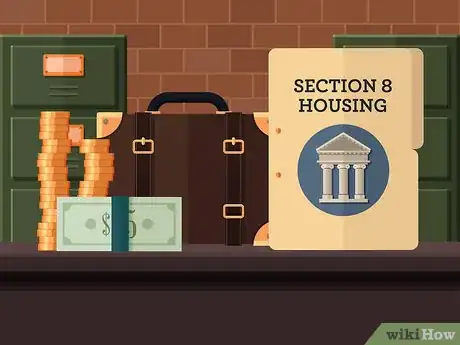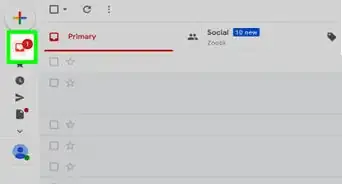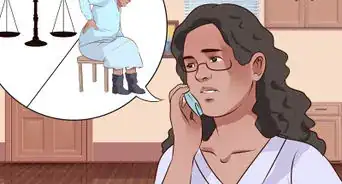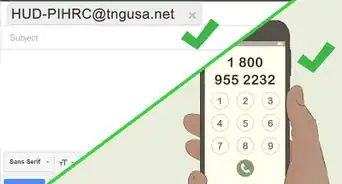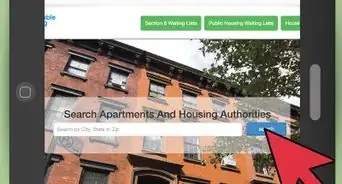This article was co-authored by Carla Toebe. Carla Toebe is a licensed Real Estate Broker in Richland, Washington. She has been an active real estate broker since 2005, and founded the real estate agency CT Realty LLC in 2013. She graduated from Washington State University with a BA in Business Administration and Management Information Systems.
This article has been viewed 577,977 times.
If you legally reside in the United States and don’t make enough money to pay your rent or mortgage, you might qualify for Section 8 housing, also known as housing choice vouchers. Although applying for government assistance can be difficult, receiving the voucher can be a big help when you’re in a tough financial situation.
Steps
Applying for Section 8 Housing
-
1Understand how Section 8 housing works. Housing choice vouchers are administered by local public housing authorities (PHA), of which there are several around the nation. Vouchers come as either project-based or tenant-based — see below for more details. The Department of Housing and Urban Development (HUD) supports PHAs, and your local PHA will help you arrange Section 8 housing.
- Under a tenant-based voucher, a tenant gets a voucher and can move into a unit with financial assistance. If that tenant chooses to move to another unit, the voucher carries over to the next unit, offering continued assistance to the tenant wherever they decide to live.
- Under a project-based voucher, a tenant gets assistance so long as they remain in the unit that the voucher was issued for. The voucher lasts for a specified unit and time. If the family chooses to leave the unit, the assistance does not carry over to the next unit. A family may still, however, be eligible for a tenant-based voucher.
-
2Determine your eligibility. Whether or not you qualify for Section 8 housing is based on multiple factors, including your family's income, the median income in your area, how much rent you're paying, your assets, and the composition of your family. Here's a general breakdown of the eligibility requirements:
- You are a US citizen or non-citizen who has eligible immigration status.
- You earn, as a family, less than 50% of the median income for the county or city in which you choose to live.[1] In fact, most Section 8 recipients earn closer to 30% of the median income for the county or metro area in which they choose to live. That's because the PHA must provide 75% of its vouchers to families who earn less than 30% of the median income.
- You meet other criteria based on assets and family composition.
Advertisement -
3Document your income and housing costs. Have pay stubs from your employer verifying your salary, and either your mortgage information or something in writing from your property owner that confirms your current rent. You'll need these documents to apply for vouchers.
-
4Know what kind of voucher you need. HUD provides assistance to both renters and homeowners. Apply for a tenant voucher if you rent the premises where you’re living. Complete a property voucher application if you would like financial assistance with paying a mortgage for a condominium, townhouse or home that you own. In some cases, Section 8 vouchers can be used to purchase a modest home and make mortgage payments.
-
5Apply for vouchers. Contact your local PHA to begin the application process. Find a list of PHAs here. Ask if it's possible to complete the forms online.
- Get assistance with completing the necessary paperwork if you’re not fluent in English. Call your local public housing authority to find out their office hours so you can complete the paperwork in person. You should be able to schedule a time with someone who can translate or to help you complete the forms.
Enrolling in Section 8 Assistance
-
1Be prepared for a long wait. In many cases, people who apply for Section 8 are waitlisted. Your local PHA may have more applications than it can afford to approve vouchers for, and will therefore have a waiting list for applicants.
- In some cases, there are as many as 100,000 applicants for only 10,000 spots. It can take upwards of 3 to 6 years in these areas to be enrolled in Section 8 while on the waiting list.[2]
- Be aware of prioritizing. PHAs develop local preferences for moving applications up or down the waiting list, and may give preference to families who are currently homeless or living in substandard housing, families who pay more than 50% of their income in rent, or families who are involuntarily displaced. Inquire at your local PHA office if you have any questions about how prioritizing is allotted.
- If the PHA in your area has more applicants than it can assist in the near future, it may temporarily stop accepting new applications.[3] Although this type of closure is not permanent, it may be beneficial to look for Section 8 housing in another county or metropolitan area if your local office is not open to new applicants.
-
2Know your responsibilities if you do get accepted. If your local PHA does approve your application and provide you with a housing voucher, you'll need to make sure that your current or intended living situation fits HUD health and safety requirements.
- Safety requirements include appropriate thermal controls, running water and sanitation systems, lack of toxic building materials, and structural integrity among other criteria.
- If you're renting, you'll be required to sign a year lease with a cooperating property owner, who will be obligated to both you and your local PHA to provide safe housing and reasonable rent.
- You'll also be required to make payments on time, maintain the unit in good condition, and comply with the terms of the lease. If you fail to pay the landlord on time, your Section 8 assistance could be revoked.
-
3Calculate your rent responsibility. Under Section 8 housing, you and your family will pay 30% of your monthly adjusted gross income on housing and utilities. Your voucher will cover the remainder of the cost. Your local PHA can help you calculate how much you need to budget for each month.
- Say, for example, your monthly income is $1,000. You'd pay $300, even if the rent of the unit is $1,000. There will likely be a cap on the maximum amount the voucher can pay based on the cost of living in your area.
-
4Avoid housing discrimination. A landlord may legally refuse occupancy for failure to pass background checks, poor credit, and other determinations, but cannot refuse occupancy to you based solely on your Section 8 enrollment.[4] Nor can a landlord charge a section 8 voucher holder more than a non-section-8 tenant.
- If you think a landlord has refused occupancy to you based solely on your Section 8 enrollment, contact your local PHA.
-
5Know what role geography plays in Section 8 enrollment. Section 8 guidelines are different from location to location. But in general, residents who receive a tenant-based voucher for the current jurisdiction in which they live may use that voucher to live anywhere in the country. Residents who do not live in the same jurisdiction in which they applied must move to the jurisdiction that issues the voucher for at least 12 months; after 12 months, they are free to move.
- Section 8 vouchers can also help you buy your home by getting a home loan at below-market interest rates. This enables you to use your voucher as a credit toward your mortgage rather than rent. Consult your local housing authority for more information.[5]
-
6Don't commit fraud. Fraud can result in termination of Section 8 assistance, as well as restitution of funds, probation, or even prison.[6] Fraud may be defined as any of the following offenses:
- Knowingly omitting or under-reporting income or assets from household income.
- Transferring assets or income to achieve eligibility.
- Falsifying or using false Social Security documents.
- Falsifying the number of members in your household.
- Getting assistance on top of Section 8 without notifying the appropriate parties
- Renting out or subletting all or part of the unit.
- Charging rent from any tenants who may be living with you.
Expert Q&A
-
QuestionI receive disability payments and get a fixed amount of money each month. However, it is very hard to find a place to live for that amount of money. Would a hardship like this enable me to qualify for section 8 housing?
 Carla ToebeCarla Toebe is a licensed Real Estate Broker in Richland, Washington. She has been an active real estate broker since 2005, and founded the real estate agency CT Realty LLC in 2013. She graduated from Washington State University with a BA in Business Administration and Management Information Systems.
Carla ToebeCarla Toebe is a licensed Real Estate Broker in Richland, Washington. She has been an active real estate broker since 2005, and founded the real estate agency CT Realty LLC in 2013. She graduated from Washington State University with a BA in Business Administration and Management Information Systems.
Real Estate Broker Consult the Housing Choice Voucher Program Guidebook. This can be obtained from the U.S. Department of Housing and Urban Development website, hud.gov.
Consult the Housing Choice Voucher Program Guidebook. This can be obtained from the U.S. Department of Housing and Urban Development website, hud.gov. -
QuestionHow can I get on a waiting list for section 8 housing?
 Carla ToebeCarla Toebe is a licensed Real Estate Broker in Richland, Washington. She has been an active real estate broker since 2005, and founded the real estate agency CT Realty LLC in 2013. She graduated from Washington State University with a BA in Business Administration and Management Information Systems.
Carla ToebeCarla Toebe is a licensed Real Estate Broker in Richland, Washington. She has been an active real estate broker since 2005, and founded the real estate agency CT Realty LLC in 2013. She graduated from Washington State University with a BA in Business Administration and Management Information Systems.
Real Estate Broker Consult the Housing Choice Voucher Program Guidebook. This can be obtained from the U.S. Department of Housing and Urban Development website, hud.gov.
Consult the Housing Choice Voucher Program Guidebook. This can be obtained from the U.S. Department of Housing and Urban Development website, hud.gov. -
QuestionWhat materials do I need to bring with me in order to apply for the section 8 voucher program?
 Carla ToebeCarla Toebe is a licensed Real Estate Broker in Richland, Washington. She has been an active real estate broker since 2005, and founded the real estate agency CT Realty LLC in 2013. She graduated from Washington State University with a BA in Business Administration and Management Information Systems.
Carla ToebeCarla Toebe is a licensed Real Estate Broker in Richland, Washington. She has been an active real estate broker since 2005, and founded the real estate agency CT Realty LLC in 2013. She graduated from Washington State University with a BA in Business Administration and Management Information Systems.
Real Estate Broker Consult the Housing Choice Voucher Program Guidebook. This can be obtained from the U.S. Department of Housing and Urban Development website, hud.gov.
Consult the Housing Choice Voucher Program Guidebook. This can be obtained from the U.S. Department of Housing and Urban Development website, hud.gov.
Warnings
- Don’t get tricked by professional scammers. There are fraudulent companies promising to help you complete the paperwork for Section 8 housing in return for a fee. You can get all the assistance you need to file for Section 8 housing free of charge simply by contacting the federal HUD office or your local public housing authority.⧼thumbs_response⧽
- This article contains legal information, but does not constitute legal advice. If you feel that you need legal advice, consult an attorney.⧼thumbs_response⧽
References
- ↑ http://portal.hud.gov/hudportal/HUD?src=/program_offices/public_indian_housing/programs/hcv/about/fact_sheet
- ↑ http://www.insidebayarea.com/ci_17060183
- ↑ http://portal.hud.gov/hudportal/HUD?src=/program_offices/public_indian_housing/programs/hcv/about/fact_sheet
- ↑ http://www.masslegalhelp.org/common-forms-of-housing-discrimination
- ↑ http://www.chfa.org/Homeownership/for%20Homebuyers/Homebuyer%20Mortgage%20Programs/Section8HomeownershipVoucherProgram.aspx
- ↑ http://www.hudoig.gov/report-fraud
About This Article
The best way to apply for Section 8 housing is to make sure you’re eligible by confirming that your family makes less than 50% of your city’s median income. Contact your local public housing authority to start the formal application process. Make sure your housing meets safety requirements and pay all of your payments on time to maintain your voucher. For tips from our Real Estate reviewer on completing specific processes and regulations, read on!


